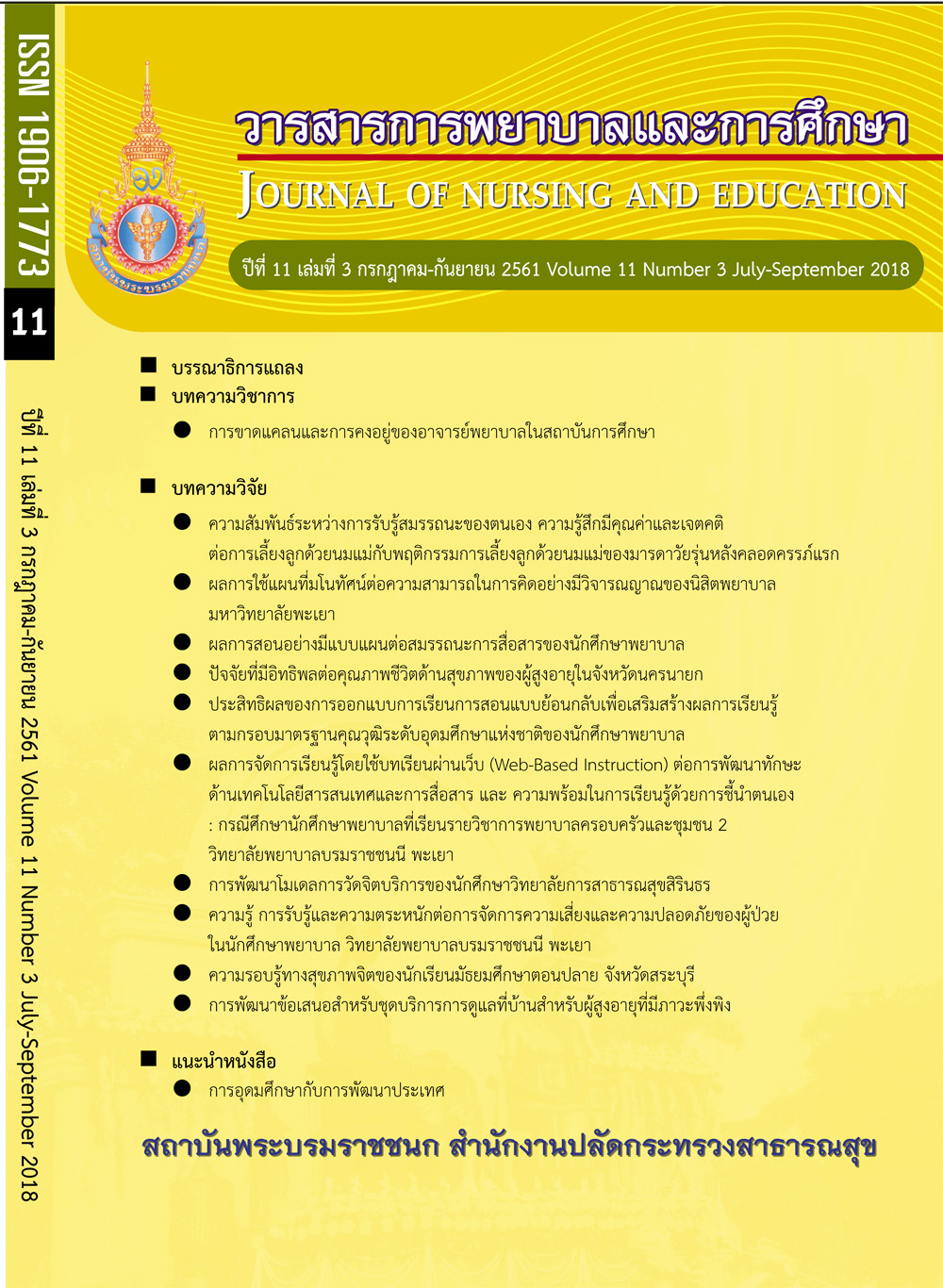ความรอบรู้ทางสุขภาพจิต ของนักเรียนมัธยมศึกษาตอนปลาย จังหวัดสระบุรี
Mental Health Literacy among Senior High School Students in Saraburi Province
คำสำคัญ:
ความรอบรู้ทางสุขภาพจิต, นักเรียนมัธยมศึกษาบทคัดย่อ
บทคัดย่อบทคัดย่อนักเรียนมัธยมศึกษาตอนปลายเป็นวัยต่อระหว่างวัยเด็กและวัยผู้ใหญ่จึงอาจเกิดความเครียดได้ง่าย ซึ่งหากมีความรอบรู้ทางสุขภาพจิตจะส่งผลให้ป้องกันการเจ็บป่วยทางจิตที่รุนแรงได้ การวิจัย ครั้งนี้มีวัตถุประสงค์เพื่อ 1) ศึกษาระดับความรอบรู้ทางสุขภาพจิตของนักเรียนมัธยมศึกษาตอนปลาย ในจังหวัดสระบุรี 2) เปรียบเทียบระดับความรอบรู้ทางสุขภาพจิตของนักเรียนที่มี เพศ ชั้นปีที่เรียน และสายการเรียนที่แตกต่างกันกลุ่มตัวอย่างเป็นนักเรียนมัธยมศึกษาตอนปลาย ปีการศึกษา 2560 จำนวน 380 คน เลือกกลุ่มตัวอย่างจากการสุ่มแบบหลายชั้นตามเพศ ชั้นปีที่เรียน และสายการเรียน จากโรงเรียนมัธยมขนาดใหญ่ จำนวน 7 โรงเรียน ในจังหวัดสระบุรี เครื่องมือที่ใช้ในการวิจัย คือ แบบประเมินความรอบรู้ ทางสุขภาพจิต วิเคราะห์ข้อมูลโดยใช้สถิติเชิงพรรณนา สถิติที และการวิเคราะห์ความแปรปรวนทางเดียว ผลการวิจัย พบว่า นักเรียนมัธยมศึกษาตอนปลายในจังหวัดสระบุร มีความรอบรู้ทางสุขภาพจิต ในระดับสูง (Mean = 33.20, S.D.= 5.29) โดยรู้จักและสามารถจำแนกปัญหาทางสุขภาพจิตได้ คิดเป็นร้อยละ 61.30 สามารถรับรู้สาเหตุของปัญหาสุขภาพจิตได้ถูกต้อง ร้อยละ 67.60 เมื่อพิจารณา ความรอบรู้ทางสุขภาพจิตในแต่ละองค์ประกอบ พบว่า กลุ่มตัวอย่างส่วนใหญ่ สามารถระบุแหล่งที่ให้ การช่วยเหลือเมื่อเกิดปัญหาสุขภาพจิตได้ มีทัศนคติที่ดีต่อผู้ที่มีปัญหาสุขภาพจิต และสามารถระบุวิธีการ จัดการเบื้องต้นเมื่อเกิดปัญหาสุขภาพจิตได้ คิดเป็นร้อยละ 98.70, 95.50 และ 91.30 ตามลำดับ นักเรียน ชั้นมัธยมศึกษาตอนปลายเพศหญิง มีความรอบรู้ทางสุขภาพจิตสูงกว่าเพศชาย อย่างมีนัยสำคัญทางสถิติ (p<.05)ส่วนชั้นปีที่เรียนและสายการเรียนที่แตกต่างกัน พบว่ามีความรอบรู้ทางสุขภาพจิตไม่แตกต่างกัน ดังนั้นจึงควรพัฒนาความรอบรู้ทางสุขภาพจิตให้กับนักเรียนเพศชาย เพื่อให้ตระหนักถึงโอกาสในการที่จะเกิดปัญหาสุขภาพจิตและหาแนวทางในการดูแลตนเองต่อไป
เอกสารอ้างอิง
1. Chuengsirakulwit, D. Counseling program, episode 3 : Introduction to mental health problems [online]. 2016 [cited 2018/2/2]. Available from:http:// www.thaiteentraining.com/ (in Thai)
2. Jorm, A. F. Mental health literacy: Public knowledge and beliefs about mental disorders. The British Journal of Psychiatry, 2000; 177(5): 396-401.
3. Doyle, E., O’Sullivan, S., Nearchou, F. & Hennessy, E. An exploration of mental health literacy in relation to depression in secondary school pupils. Journal of Education and Training,
2017; 4 (2): 1–13.
4. O’Connor, M., & Casey, L. The Mental Health Literacy Scale (MHLS): A new scale-based measure of mental health literacy. Psychiatry Research, 2015;
229(1-2): 511-516.
5. Kaewprom, C., Yuthavisut, S., Pratoom, L. & Boontum, A. Mental health literacy among village health workers: a case study of two sub-districts in Kloong, Chantaburi. Journal of Health Science Research, 2014; 8(1): 10-16. (in Thai)
6. Attygalle, Perera & Jayamanne. Mental health literacy in adolescents: ability to recognise problems, helpful interventions and outcomes. Child and Adolescent Psychiatry and Mental Health, 2017: 1-8.
7. Melas, P. A., Tartani, E., Forsner, T., Edhborg, M., and Forsell, Y. Mental health literacy about depression and schizophrenia among adolescents in Sweden. European Psychiatry, 2013;
28: 404–411.
8. Coles, M. E., Ravid, A., Gibb, B. Denn, D., Bronstein, L. R., and McLeod, S. Adolescent mental health literacy: young people’s knowledge of depression and social anxiety disorder. Journal of Adolescent Health, 2016; 58: 57-62.
9. Agakul, T. Research methodology behavioral sciences and social sciences. 5th edition. Ubon Ratchathani: Witthaya offset printing, 2007.
10. Guptab, Kamlesh, Sharmab, Rakesh,
& Chaddac. Awareness of mental disorders among youth in Delhi Arun Deva, Sandhya. Current Medicine Research and Practice, 2017; 7: 84–89.
11. Lewinsohn, P. M., Rohde, P., Seeley, J. R., Klein, D. N., & Gotlib, I. H. Psychosocial functioning of young adults who have experienced and recovered from major depressive disorder during adolescence. Journal of Abnormal Psychology, 2003;
112: 353-363.
12. Vatanasin, D. Prevention of adolescent depression: evidence to practice. The Journal of Faculty of Nursing, Burapha University, 2016; 24(1): 1-12. (in Thai)
13. Triruangworawat, B. Medhubnews. com [online]. 2017 [cited 2017/2/3]. Available fromhttps://medhubnews. com/article-8341-1-1.
14. Tooglang, S, Thongtang, O., Satra, T., & Phattharayuttawat, S. Factors influencing depression among early adolescents in extended educational opportunity school of Samutsakhon province. J Psychiatr Assoc Thailand,
2012; 57(3): 283-294. (in Thai)
15. National Statistical Office. Adolescent: internet: online game [online]. 2011 [cited 2018/2/13]. Available from: http://service.nso.go.th/nso/nsopub- lish/citizen/news/news_internet_teen. jsp (in Thai)
16. Melas, Tartani, Forsner, Edhborg, & Forsell. Mental health literacy about depression and schizophrenia among adolescents in Sweden. European Psychiatry [online]. 2013 [cited 2018];
28: 404-411. Available from: http://dx.doi.org/10.1016/j.eurpsy.2013.02.002
17. Chantarasiripoot, B., Rongsawat, P., Musigawan, A., & Dumrongsaree, P. Mental health and mental health self-care behaviors among adolescents in secondary schools, Yala province, Thailand. Journal of Nursing and Education, 2014; 7(1): 68-80. (in Thai)
18. Phumipak, C. Teacher’s guideline of learning plans of health and physical education learning area: health education and physical education
1, senior high school (Grade 10-12), the basic education core curriculum B.E. 2551. Bangkok: Wattanapanit, 2008.
19. Puaskul, I. Mental health promotion handbook for secondary school teachers.
6thedition. Bangkok: Department of Mental Health, Ministry of Public Health, 2001.






